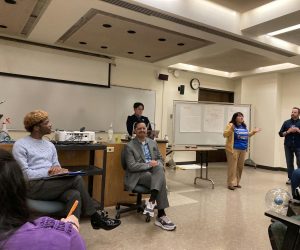Beyond The NEIU Campus –– “Open House Chicago” And Its Relevance To All Students
October 4, 2022
“Open House Chicago” is a free annual upcoming citywide event and includes some select suburbs with architectural significance, such as Evanston and Oak Park. “Open House Chicago” is organized by the Chicago Architecture Center. The event takes place in the middle of October every year. This year it will take place on Oct. 15 and 16. The purpose of the event is to host architecturally significant structures throughout our glorious city. In a nutshell, “Open House Chicago” is all about urban exploration, discovering nifty new places and rediscovering old places from new perspectives. It is much like those “Walking Wednesdays” that take place in and around the NEIU campus. In short, “Walking Wednesdays” are 35-minute jaunts of urban exploration around the NEIU campus that take place each week on Wednesdays. The most obvious example of architecture found on the NEIU campus would be the Bernard J. Brommel Hall (BBH), commonly referred to as ‘the ramp building’ or ‘the building with the ramps.’ Particularly, the ramps are a key facet of architecture because they define the way in which people use them instead of the need for stairs or elevators. It would have been cool if BBH was sensationalized by being entered into the “Open House Chicago” event but perhaps next year. The tiled mosaic that surrounds the perimeter of several NEIU buildings below the roof’s edge is another example of architecture on the NEIU campus in terms of façade. Thus, architecture can be found just about everywhere in the built environment.
NEIU has an architecturally-enthused student organization called NEIU Artists & Designers Association Club. This club meets on Thursdays at 4 p.m. in the Fine Arts Center. One member of this club, Derek Ramos, a graphic design major, insists that “architecture is one of the most important art forms [because] architecture can be used to communicate ideas, feelings and messages,” that were intended by design. Visitors and residents alike would agree that the Chicago skyline is beautiful thanks to its magnificent architecture, and Ramos is no exception because he has stated that architecture “can also be used to simply make a statement or to create a feeling of beauty or awe.”
As an NEIU student, you may be thinking how architecture may influence you when you are likely not an architect. Architecture is not just about the façade of a building or understanding floor plans of a building, but it shapes the way people use the structure. For instance, the built infrastructure is a concept in public health, and it permits how people will use a facility. On one hand, when a city center is built around motorized means of transportation, sidewalks and bicycle paths will likely be ignored with a low priority threshold. On the other hand, when a city center is built for people to interact with one another, that place will be idolized as an attractive feature in a city for eating, drinking, playing, dancing, street theater, live music, bicycling, walking, running and meeting up with people.
In a research article titled, “The Built Environment and Depression in Later Life: The Health In Men Study,” published in The American Journal of Geriatric Psychiatry in 2011, has discovered that when retail spaces with larger parking lots are a part of people’s neighborhoods, those people are more likely to experience depression in old age. Part of this dilemma is due to the fact that parking lots inhibit social interaction between people. Furthermore, the neighborhoods are built for motorized vehicles and not prioritized for pedestrians.
Architecture is not just about the artistry but the interaction between people and location. It involves architects, construction workers, physicists, city planners, surveyors, geographers, researchers, analysts, epidemiologists, statisticians and the people who actually live in the particular neighborhood. As you can tell, the list is nearly endless in terms of related professions. Ramos also agrees with the interdisciplinary sentiment of architecture by saying architecture allows “expressing oneself through the design and construction of buildings and other structures.” Furthermore, when cities are built for people instead of automobiles, the probability of obesity, heart disease, depression and air and noise pollution decrease. In addition, after reflecting on Ramos’ previous sentiment, designing and building a city for the people leads to the people’s expression being inevitably fulfilled. The bottom line is that as long as you live in a built infrastructure, you should care about architecture because it impacts your life in more ways than you think.
In a research article titled, “The Built Environment as Determinant of Childhood Obesity: A systematic literature review,” in Obesity Reviews published in 2021, has found that a strong correlation exists between increased traffic-caused air pollution, decreased walkability of neighborhoods, and increased childhood obesity. As you can see, whether you are a young child, an elderly person, or somewhere in between, your architectural environment and exposure to built structures affect your lifestyle deeply.
Regardless of your major at NEIU, architecture affects you, and is definitely potent enough to have a lasting outcome on your lifestyle. You just have to be an observer of your surroundings to figure it out. Thus, get out there, and explore your world!
External Sources:
Saarloos, D., Alfonso, H., Giles-Corti, B., Middleton, N., & Almeida, O.P. (2011). The Built Environment and Depression in Later Life: The Health In Men Study. The American Journal of Geriatric Psychiatry, 19(5), 461–470. https://doi.org/10.1097/JGP.0b013e3181e9b9bf
Malacarne, D., Handakas, E., Robinson, O., Pineda, E., Saez, M., Chatzi, L., & Fecht, D. (2021). The built environment as determinant of childhood obesity: A systematic literature review. Obesity Reviews, 23(S1), 1–11. https://doi.org/10.1111/obr.13385









